Customer Lifecycle and Online Stores: Everything You Need to Know
If you click to purchase a product or service based on our independent recommendations and impartial reviews, we may receive a commission. Learn more
If you’ve built your own online store and run your own business, you should already know how important it is to understand the needs and pain points of your customers. With a customer lifecycle, you can easily track and monitor the customer experience, from initial brand awareness to maintaining the relationship post-sale.
Customers are overwhelmed with choices nowadays, and finding ways to attract them to your online store is more difficult than ever. But with dedicated content and marketing strategies for each stage, your business can connect with customers throughout their shopping journey.
In this article, we’ll examine what we mean by a customer lifecycle, the five main stages, and best practices when linking the customer lifecycle with your online store.
What Is the Customer Lifecycle?
The customer lifecycle follows the path customers take as they advance through the sales funnel, from awareness to brand loyalty. This, in turn, helps businesses shape marketing decisions and nurture beneficial customer relationships.
To put it simply, the customer lifecycle gives an overview of customer behavior and helps businesses discover strategic opportunities, rather than focusing attention on a single sale or metric. It involves building long-term relationships with customers, managing their experiences, and delivering optimized messaging for each stage.
The goal is to produce content that specifically targets each touchpoint in the customer journey and to measure the success of these actions.
It’s a never-ending loop, not a journey from point A to point B – once a customer has converted and started a relationship with your business, the work doesn’t stop. Your business should continue to make them aware of new products and deliver content to drive them toward additional purchases.
Find Out More
If you want to trace every stage of your customer lifecycle, check out our guide to the Customer Journey Map, a visual representation of your customer journey.
The 5 Main Stages of the Customer Lifecycle
As we’ve already mentioned, the customer lifecycle gives an online store the opportunity to step back from the individual customer touchpoints and view the journey as a whole. Still, the lifecycle can be broken down into five main stages, each reflecting a different step in the customer journey:
- Reach
- Acquisition
- Conversion
- Retention
- Loyalty
Despite the fact that each stage requires unique actions to be taken, and success is measured in varying ways across the lifecycle, the five main stages are all connected. You can’t achieve brand loyalty without first building brand awareness, for example.
Let’s get started:
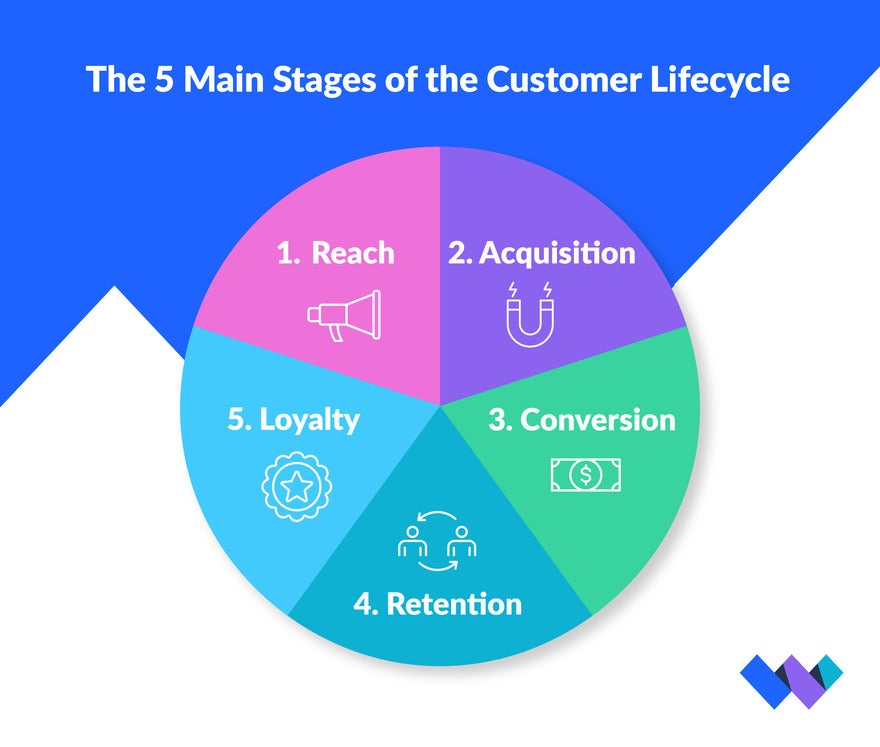
#1. Reach
At the beginning, a customer is on the search for the perfect product or service to solve a problem. The key question for your business is: Can customers find you?
To help them, your business can build brand awareness by posting regularly on social media, creating relevant content for your site, promoting positive experiences, and ensuring your business performs well across search engines, also known as search engine optimization (SEO).
The market is competitive, so you want your business to position itself as the solution to the customer’s issue – the customer is doing their own research and comparison, and the steps we’ve outlined should help your business stand out from the crowd.
When reaching out to new customers, we recommend measuring success through the number of website visitors, your post impressions, and your follower count across platforms.
#2. Acquisition
Once a customer has become aware of your online store and what you have to offer, the next question is: Do you have the information and resources available for customers to make a decision?
The acquisition stage is all about generating leads and locking the customer in so they feel satisfied and confident enough to proceed with a purchase. Through understanding your target audience, you can produce content to help the customer make an informed decision. For example, a blog post on how to use a product correctly, or a table detailing shipping costs.
Thankfully, many website builders boast AI developments that are designed to help with this stage. An example is Shopify’s new AI powered semantic search tool, announced in its Winter ‘24 Edition. This search tool will optimize your pages by not only considering your keywords, but also any related synonyms and natural phrasing that a site visitor may search for. This works to streamline the process of finding your products and improve user experience.
A good way to monitor a customer’s interest in your business is to track how long they spend on your site browsing, if they’re adding items to their cart, and how much they actively engage with your content.
#3. Conversion
Here comes the exciting part – a sale! After finding your business and reviewing resources to make an informed decision (thanks to your expert content), the customer is ready to buy, buy, buy.
This positive experience has moved the user into the conversion stage of the customer lifecycle, and it’s time to water your blossoming customer relationship.
Now’s your chance to evaluate your purchasing process and see if anything can be improved. What prevents a customer from converting?
Your checkout page could be too time-consuming or complicated, or you might have a poor refund policy. Whatever it is, it’s best to keep things simple and easy to find. Using these problems as an example, you should optimize your checkout page and spend time improving your returns management to help convert your visitors into buyers.
Thankfully, sales are very easy to keep track of and it’s pretty obvious if the business is thriving or failing. Take a look at your lead conversion rates, average order value, and general revenue.
#4. Retention
After a customer has placed enough trust in your brand to make a purchase, it’s now time to maintain that relationship. The customer lifecycle isn’t just about attracting new customers, but also retaining existing ones too – as a business, you can learn from their reviews and feedback to kickstart positive change.
So, how can you make the customer experience better?
Customers want to feel special and valued by a business, so checking in with post-purchase surveys or personalized content is a great way to keep the relationship alive. You can ask questions, such as:
- Were they happy with their purchase?
- What was their experience like shopping with your store?
- Did your business provide great customer service?
- Is there anything to improve?
You could even establish a customer loyalty program with exclusive benefits, such as discounts or referral codes, to further entice customers to stick around!
The retention stage relies heavily on how a customer feels after engaging with your business, but don’t worry, there are still effective ways to monitor customer behavior. You can keep an eye on subscription rates, the number of repeat purchases made, and social media engagement, for example.
#5. Loyalty
The ultimate goal from the customer lifecycle is loyalty to your business. Following a positive experience through the previous stages of the lifecycle, the customer essentially becomes a brand ambassador.
They can help your business grow through the actions they take, whether that’s sharing posts about their purchase on social media (and creating user-generated content), referring friends and family to your online store, or writing product reviews.
As a business owner, you have to ask yourself: Will your customers return and how can you maximize each customer’s potential?
An engaged and loyal customer is more likely to purchase items they love time and time again, plus they’re eager to hear about new products and brand updates. Still, it’s important as a business owner that you take the time – through each customer lifecycle stage – to prove how valuable your business, product, and services are to the customer.
To measure brand loyalty, we’d recommend taking a look at how well received your business is across review sites and forums. Gathering a customer satisfaction score (CSAT) is also a great metric to have.
How to Manage the Customer Lifecycle When Creating Your Online Store
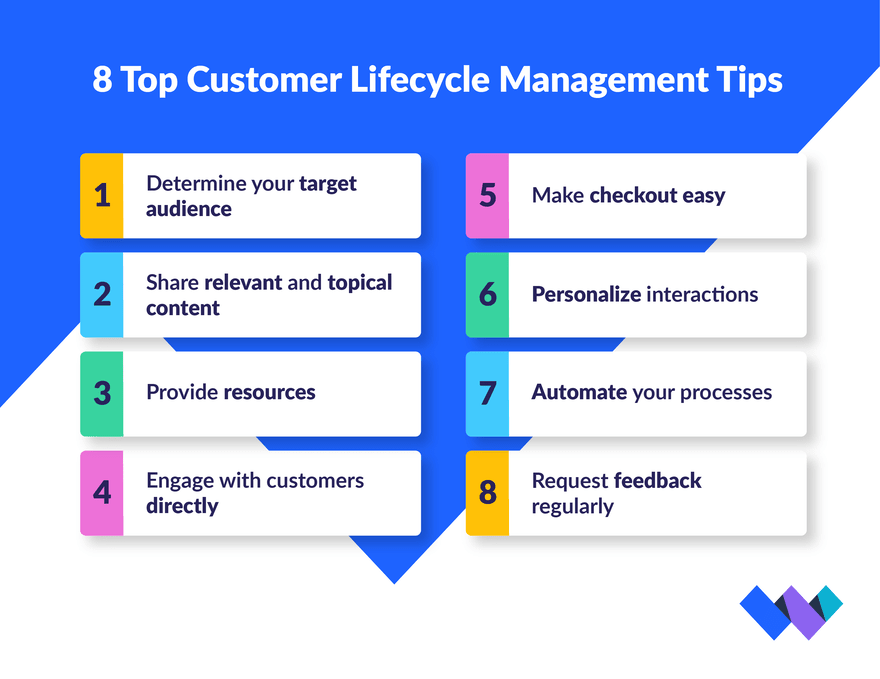
We’ve already examined the main stages of the customer lifecycle, but how can you use this strategy effectively for your online store?
It’s common knowledge that a better customer experience will result in happy customer relationships and more sales. By following the steps below, you can start to optimize your business, strategies, and content according to the customer lifecycle.
Here are eight top tips for managing the customer lifecycle with your online store:
Determine Your Target Audience
Identifying your target audience and building user personas should be your first step when starting a business. It’ll give you everything you need to create a targeted marketing plan that effectively attracts that audience.
A keen awareness of your target market is especially important at the start of a customer relationship when you’re building brand awareness. So put yourself in their shoes; what do they like and dislike? What are their pain points? How could you solve their problem with your product or service?
Share Relevant and Topical Content
With your target customer in mind, you can share relevant and topical content that they would appreciate. For example, if you run a pet store, there’s no need to post content on the latest fashion trends for women – save this for your personal account!
Instead, you should be posting about your supplies and anything related that would interest your buyers and influence purchases; sharing an article about the health benefits of walking your dog could make them want to buy your extendable leash!
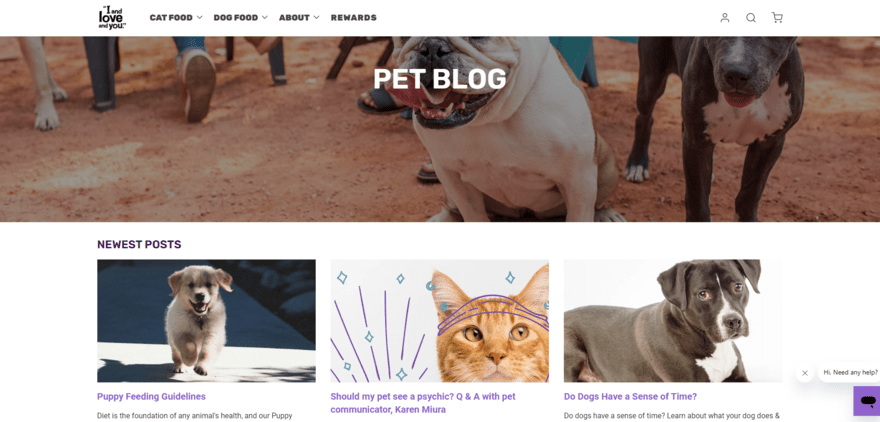
Getting to grips with using socials is an important part of encouraging a sense of personality and trust behind your brand name. If you’re not sure how to grow your business on social media, you should start by searching for your keywords and following other similar businesses to gain inspiration from what they’re posting.
Provide Resources
When a customer is in the acquisition stage, you can help make their decision process easier by providing all of the necessary information – and to a high standard. Take clear product photos at all angles, be transparent about pricing, and include all the important information in your product descriptions. Customers should be able to easily find whatever they need on your website or brand pages.
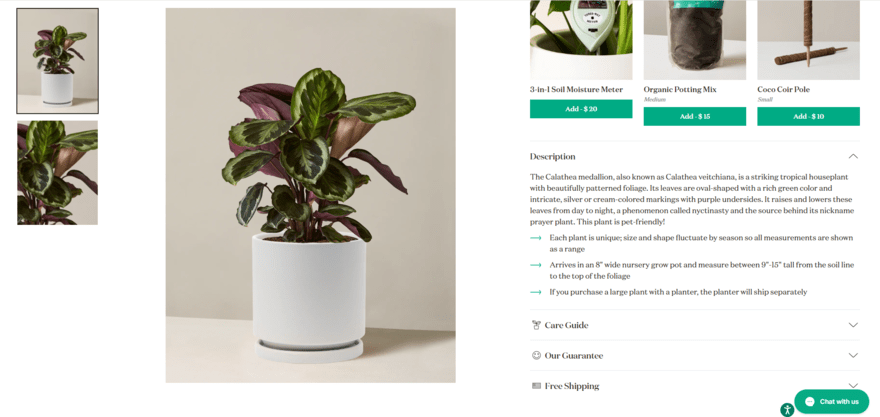
In the above example, houseplant business The Sill has thought about their user personas when creating their product listings. Their product care guide includes information about whether the plant is pet safe, how easy it is to look after, and even troubleshooting “sad plant” signs. These facts squash worries relating to their customers’ pain points, which might otherwise deter a purchase.
Most ecommerce builders and storefronts now have AI features to help you craft captivating product titles and descriptions. All you have to do is enter the keywords and phrases that you want to include, and voilà! Just be sure you give it a once over though, because AI-written content can sometimes need tweaking to sound natural.
Engage With Customers Directly
Be proactive and reach out to your target audience to share how you can best serve them as a business, whether that’s through free trials or any promotions that will be of interest to them. It’s important that you think about the methods of communication your customers will find the most engaging, as well as the method most suited to your business and the information you want to relay. For instance, email marketing will give you the freedom to share both long and short messages with your customers and embed media and CTAs, like in the example below.
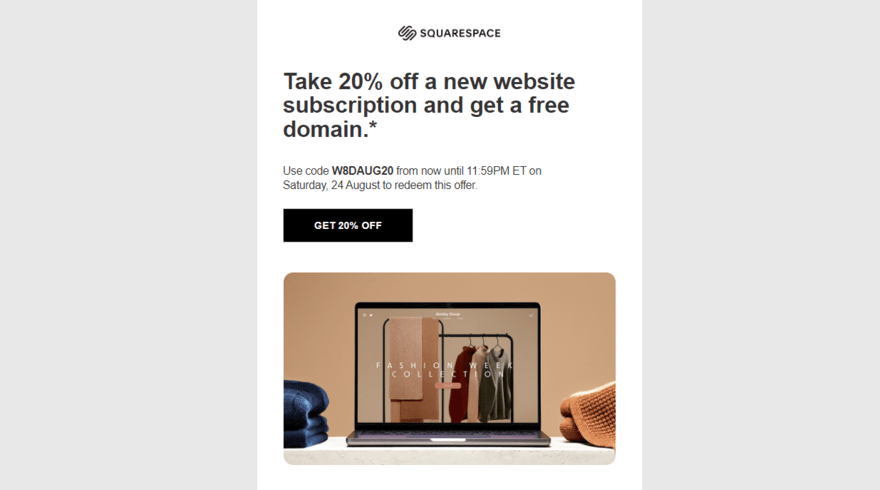
On the other hand, SMS marketing is a more direct way to share information that can be expressed in a short sentence, such as limited website sales. Rather than being sent as an email that the customer will have to open to read fully, SMS promotion will be sent directly to their mobile as a text which can make them see the information faster.
This being said, there’s a risk of customers getting frustrated if these forms of communication are used too frequently, so it’s important to adhere to both SMS and email marketing best practices to avoid customers unsubscribing.
Make Checkout Easy
Once your customer is ready to convert, it’s best to make your checkout process seamless to avoid cart abandonment or customer frustration. We’d recommend a single checkout page and lots of payment options. Our favorite checkout page examples will give you further inspiration and guidance on what makes a great checkout experience.
Personalize Interactions
Creating a personalized online shopping experience is especially important when attracting new customers or when managing customers post-purchase. Pre-sale, it could help them to navigate your site smoothly to find the right products for them, and post-sale, personalization makes the buyer feel special, which tends to increase their patience if you run into any problems with shipping or stock.

For example, you could divide your site into sections based on purpose or style choices, include product recommendations, or even add quizzes to provide curated product suggestions. After a purchase, customers will always appreciate a thank you message, transparent delivery updates, and emails about sales on related products they might be interested in.
Automate Your Processes
A great tip to help you manage your store with ease is to automate your processes and workflows, especially as your audience grows.This can help with anything from automatically sending order management emails, posting to social media accounts, and requesting feedback from customers.
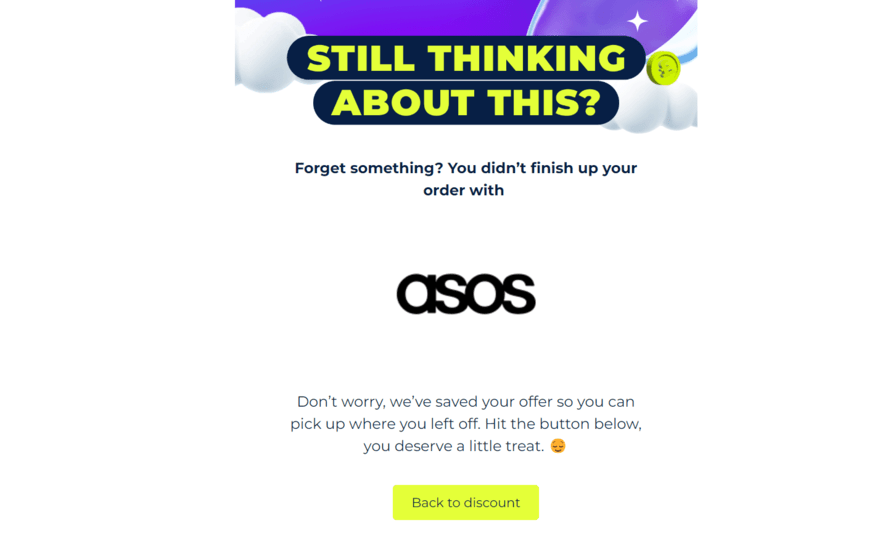
Taking advantage of automation tools will not only save you time but reduce room for inconsistencies or errors, and can improve your customers’ overall experience.
Request Feedback Regularly
Comments, surveys, and reviews are a great source of information and a key way to find out how customers really feel. They’re also the first thing potential customers see when searching for your business, so knowing how to ask customers for reviews is super important – it not only encourages positive feedback and reviews, it can also help your business spot areas in need of improvement. Requesting constructive feedback really shows your customer that you care about their individual sale and want to make their experience perfect.
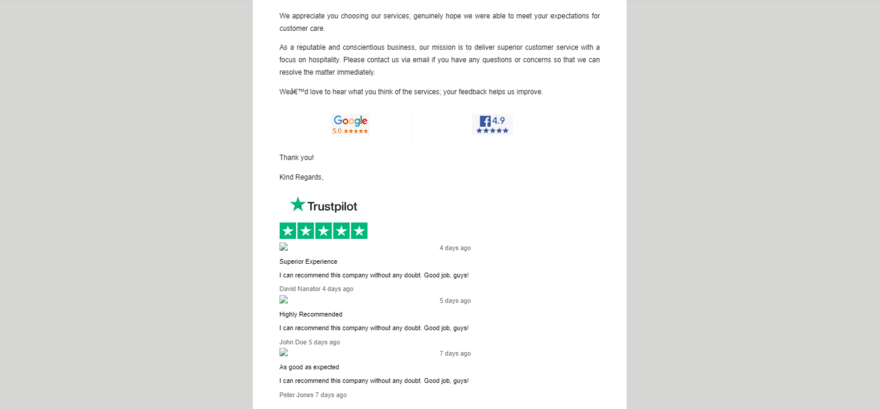
Receiving this email tied together the great service I’d had throughout my customer journey and encouraged me to write a Google review when I normally wouldn’t. Reviews are also effective at attracting new customers and maintaining those all-important customer relationships.
Summary
The customer lifecycle is there to help your business find and connect with more customers – you can customize your marketing and strategies to better serve your customers, and discover opportunities for growth and success.
As we’ve discussed, the customer lifecycle covers the entire customer journey, from initial awareness to becoming a long-term customer. Understanding each stage allows you, as a business owner, to overcome common ecommerce challenges, successfully guide customers along the sales funnel, and create positive consumer experiences.
The advice in this article should help you get started but, most of all, you must always remember to focus on every stage of the customer lifecycle and keep your messaging consistent and relevant. Your strategy should tie back to the needs of your customers at every point and help position your business as the perfect solution to their problem.

Leave a comment